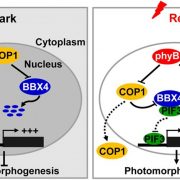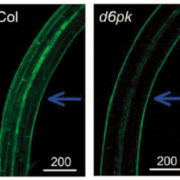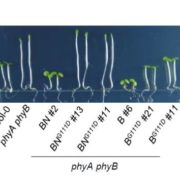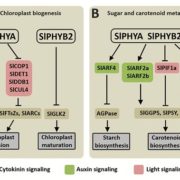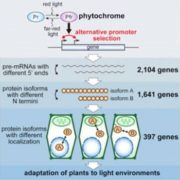A novel hyperactive UVR8 variant for enhanced UV-B responses (PNAS)
 Plants perceive UV-B radiation using a specialized photoreceptor protein called UVR8. Upon UV-B exposure, activated UVR8 initiates a signaling cascade, inducing a range of morphological and biochemical responses that facilitates UV adaptation. In a mutagenesis screen, Podolec et al. identified a mutant named uvr8-17D, which produces a hyperactive variant of UVR8, harbouring a glycine-101 to serine change (G101S). The mutant seedlings, although grew normally under white light, exhibited hypersensitive phenotypes and enhanced survivability under UV-B radiation. Generally, UVR8 proteins are inactive homodimers in their ground state and become active monomers when exposed to UV-B. Interestingly, UVR8G101S encoded by uvr8-17D is constitutively monomeric, making it weakly active even in the absence of UV-B. Under UV-B, UVR8G101S is imported more into the nucleus due to its enhanced interaction with COP1. UVR8 photocycle becomes complete only when the monomers are recruited and brought back into inactive homodimers by RUP1 and RUP2. In uvr8-17D, this photocycle remains incomplete due to the inability of UVR8G101S to form homodimers. Detailed structural analysis revealed that the G101S mutation in UVR8 distorts the conformation of a loop that is crucial for its homodimerization. Together, the enhanced UV-B signaling by this novel hyperactive UVR8 variant increases the sensitivity and response of plants to UV-B radiation, which can be highly useful for fundamental research as well as crop improvement programs in future. (Summary by Yadukrishnan Premachandran @yadukrishprem) Proc. Natl. Acad. Sci. USA 10.1073/pnas.2017284118
Plants perceive UV-B radiation using a specialized photoreceptor protein called UVR8. Upon UV-B exposure, activated UVR8 initiates a signaling cascade, inducing a range of morphological and biochemical responses that facilitates UV adaptation. In a mutagenesis screen, Podolec et al. identified a mutant named uvr8-17D, which produces a hyperactive variant of UVR8, harbouring a glycine-101 to serine change (G101S). The mutant seedlings, although grew normally under white light, exhibited hypersensitive phenotypes and enhanced survivability under UV-B radiation. Generally, UVR8 proteins are inactive homodimers in their ground state and become active monomers when exposed to UV-B. Interestingly, UVR8G101S encoded by uvr8-17D is constitutively monomeric, making it weakly active even in the absence of UV-B. Under UV-B, UVR8G101S is imported more into the nucleus due to its enhanced interaction with COP1. UVR8 photocycle becomes complete only when the monomers are recruited and brought back into inactive homodimers by RUP1 and RUP2. In uvr8-17D, this photocycle remains incomplete due to the inability of UVR8G101S to form homodimers. Detailed structural analysis revealed that the G101S mutation in UVR8 distorts the conformation of a loop that is crucial for its homodimerization. Together, the enhanced UV-B signaling by this novel hyperactive UVR8 variant increases the sensitivity and response of plants to UV-B radiation, which can be highly useful for fundamental research as well as crop improvement programs in future. (Summary by Yadukrishnan Premachandran @yadukrishprem) Proc. Natl. Acad. Sci. USA 10.1073/pnas.2017284118


